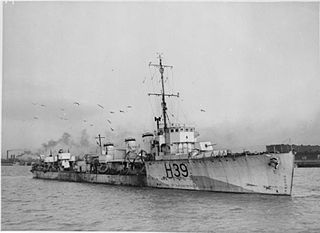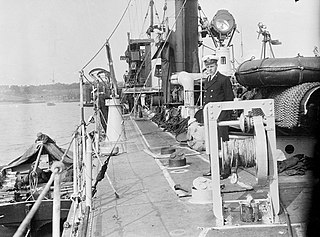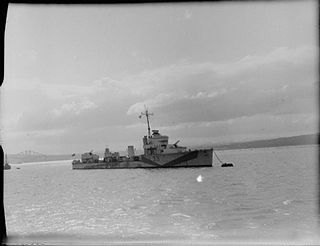HMS Sceptre was an R-class destroyer of the Royal Navy, built by Alexander Stephen and Sons, at Linthouse and launched on 18 April 1917. In total 51 ships were in this class and saw service in World War I, entering service from 1916 to 1917 and suffering comparatively light losses. Sceptre saw action as part of the Harwich Force, operating mainly in the North Sea. She survived the war and was sold for disposal in 1926.

HMS Aurora was an Arethusa-class light cruiser that saw service in World War I with the Royal Navy. During the war, the cruiser participated in the Battle of Dogger Bank and was a member of the Grand Fleet when the main fleet of the Imperial German Navy surrendered to it in 1918. Following the war, Aurora was placed in reserve and in 1920, the cruiser was transferred to the Royal Canadian Navy. Her service with the Royal Canadian Navy was brief, being paid off in 1922. The cruiser was sold for scrap in 1927 and broken up.

HMS Lance was a Laforey-class destroyer of the Royal Navy. Launched a few months before the outbreak of the First World War and attached to the Harwich Force, Lance took part in several engagements during the war, including the sinking of the Königin Luise and the Battle off Texel. She was responsible for firing the first British shot of the war.

HMS Skate was an R-class destroyer of the Royal Navy that was laid down and completed during the First World War. She was built at John Brown Shipyard at Clydebank in Scotland and launched on 11 January 1917.

HMS Laforey was the lead ship of her class of destroyer built for the Royal Navy. Launched a year before the First World War began, she was attached to the Dover Patrol. Laforey saw action in several engagements with German torpedo boats, including the Battle off Noordhinder Bank and the action of 17 March 1917. Laforey was sunk in 1917 by a British mine after escorting several freighters to France. She was named for Francis Laforey, captain of HMS Spartiate at the Battle of Trafalgar in 1805.

HMS Kale was a Hawthorn Leslie type River-class destroyer ordered by the Royal Navy under the 1903–1904 Naval Estimates. Named after the Kale Water in the Scottish Borders, she was the first ship to carry this name in the Royal Navy.
Chios was a Medea-class destroyer laid down for the Greek Navy by Fairfield Shipbuilding and Engineering Company, Govan in 1914. She was launched as 16 December 1914 and completed for service in the Royal Navy as HMS Melampus on 29 June 1915. On 16 April 1917 she accidentally rammed and sank the C-class submarine C16. She was sold for breaking up on 22 September 1921.

HMS Meteor was a Thornycroft M-class destroyer that served in the British Royal Navy. Meteor saw extensive service throughout World War I, maintaining continuous operations both as a convoy escort and in harbour protection.
HMS Colne was a Thornycroft type River-class destroyer ordered by the Royal Navy under the 1903–1904 Naval Estimates. Named after the River Colne in eastern England, north east of London, she was the first ship to carry this name in the Royal Navy.

HMS Vectis (D51) was a V-class destroyer of the British Royal Navy that saw service in World War I and the Russian Civil War.

The first HMS Walrus (D24) was a W-class destroyer of the British Royal Navy that saw service in the final months of World War I.

HMS Vivien (L33) was a V-class destroyer of the British Royal Navy that saw service in World War I and World War II.
HMS Ouse was a Laird type River-class destroyer ordered by the Royal Navy under the 1903 – 1904 Naval Estimates. Named after the River Ouse in north east England near the city of York, she was the first ship to carry this name in the Royal Navy.

HMS Arun was a Laird Type River-class destroyer ordered by the Royal Navy under the 1902–1903 Naval Estimates. Named after the River Arun in southern England she was the first ship to carry this name in the Royal Navy.
HMS Moy was a Laird Type River-class destroyer of the Royal Navy. Named after the River Moy in Ireland, she was the first ship to carry this name in the Royal Navy.
HMS Rother was a Palmer type River-class destroyer ordered by the Royal Navy under the 1902–1903 Naval Estimates. Named after the River Rother, east of Sheffield, South Yorkshire in England, she was the first ship to carry this name in the Royal Navy.

HMS Chelmer was a Thornycroft-type River-Class destroyer ordered by the Royal Navy under the 1903–1904 Naval Estimates. Named after the River Chelmer in eastern England, north-east of London, she was the first ship to carry this name in the Royal Navy.
HMS Murray was a Royal Navy Admiralty M-class destroyer. Ordered before the outbreak of war, she was therefore the first of her class to enter operation during the early months of the First World War. She was also the first vessel of the Royal Navy to carry the name HMS Murray.

HMS Lawford was a Laforey-class destroyer of the British Royal Navy. The Laforey class was the class of destroyers ordered under the Royal Navy's 1912–1913 construction programme, which were armed with three 4-inch (102 mm) guns and four torpedo tubes and were capable of 29 knots. The ship, which was originally to be named Ivanhoe but was renamed before launch, was built by the Scottish shipbuilder Fairfields between 1912 and 1914.
HMS Sturgeon was an R-class destroyer of the British Royal Navy. Sturgeon was built built by Alexander Stephen and Sons in Glasgow, Scotland, and was launched on 11 January 1917 and completed in February that year. The ship took its name after Sturgeon, a freshwater fish.












